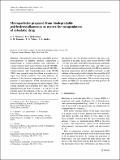| dc.contributor.author | Murueva, A. V. | |
| dc.contributor.author | Shishatskaya, E. I. | |
| dc.contributor.author | Kuzmina, A. M. | |
| dc.contributor.author | Volova, T. G. | |
| dc.contributor.author | Sinskey, Anthony J | |
| dc.date.accessioned | 2016-11-07T21:44:55Z | |
| dc.date.available | 2016-11-07T21:44:55Z | |
| dc.date.issued | 2013-05 | |
| dc.date.submitted | 2012-07 | |
| dc.identifier.issn | 0957-4530 | |
| dc.identifier.issn | 1573-4838 | |
| dc.identifier.uri | http://hdl.handle.net/1721.1/105240 | |
| dc.description.abstract | Microparticles made from degradable polyhydroxyalkanoates of different chemical compositions a homopolymer of 3-hydroxybutyric acid, copolymers of 3-hydroxybutyric and 4-hydroxybutyric acids (P3HB/4HB), 3-hydroxybutyric and 3-hydroxyvaleric acids (P3HB/3HV), 3-hydroxybutyric and 3-hydroxyhexanoic acids (P3HB/3HHx) were prepared using the solvent evaporation technique, from double emulsions. The study addresses the influence of the chemical compositions on the size and ξ-potential of microparticles. P3HB microparticles loaded with doxorubicin have been prepared and investigated. Their average diameter and ξ-potential have been found to be dependent upon the level of loading (1, 5, and 10 % of the polymer mass). Investigation of the in vitro drug release behavior showed that the total drug released from the microparticle into the medium increased with mass concentration of the drug. In this study mouse fibroblast NIH 3T3 cells were cultivated on PHA microparticles, and results of using fluorescent DAPI DNA stain, and MTT assay showed that microparticles prepared from PHAs of different chemical compositions did not exhibit cytotoxicity to cells cultured on them and proved to be highly biocompatible. Cell attachment and proliferation on PHA microparticles were similar to those on polystyrene. The cytostatic drug encapsulated in P3HB/3HV microparticles has been proven to be effective against HeLa tumor cells. | en_US |
| dc.description.sponsorship | Russia (Federation) (Agreement 11.G34.31.0013) | en_US |
| dc.description.sponsorship | Program of the President of Russia for Young Doctors of Sciences (Grant MD-3112.2012.4) | en_US |
| dc.publisher | Springer US | en_US |
| dc.relation.isversionof | http://dx.doi.org/10.1007/s10856-013-4941-2 | en_US |
| dc.rights | Creative Commons Attribution-Noncommercial-Share Alike | en_US |
| dc.rights.uri | http://creativecommons.org/licenses/by-nc-sa/4.0/ | en_US |
| dc.source | Springer US | en_US |
| dc.title | Microparticles prepared from biodegradable polyhydroxyalkanoates as matrix for encapsulation of cytostatic drug | en_US |
| dc.type | Article | en_US |
| dc.identifier.citation | Murueva, A. V. et al. “Microparticles Prepared from Biodegradable Polyhydroxyalkanoates as Matrix for Encapsulation of Cytostatic Drug.” Journal of Materials Science: Materials in Medicine 24.8 (2013): 1905–1915. | en_US |
| dc.contributor.department | Harvard University--MIT Division of Health Sciences and Technology | en_US |
| dc.contributor.department | Massachusetts Institute of Technology. Department of Biology | en_US |
| dc.contributor.department | Massachusetts Institute of Technology. Engineering Systems Division | en_US |
| dc.contributor.mitauthor | Sinskey, Anthony J | |
| dc.relation.journal | Journal of Materials Science: Materials in Medicine | en_US |
| dc.eprint.version | Author's final manuscript | en_US |
| dc.type.uri | http://purl.org/eprint/type/JournalArticle | en_US |
| eprint.status | http://purl.org/eprint/status/PeerReviewed | en_US |
| dc.date.updated | 2016-08-18T15:42:19Z | |
| dc.language.rfc3066 | en | |
| dc.rights.holder | Springer Science+Business Media New York | |
| dspace.orderedauthors | Murueva, A. V.; Shishatskaya, E. I.; Kuzmina, A. M.; Volova, T. G.; Sinskey, A. J. | en_US |
| dspace.embargo.terms | N | en |
| dc.identifier.orcid | https://orcid.org/0000-0002-1015-1270 | |
| mit.license | OPEN_ACCESS_POLICY | en_US |
| mit.metadata.status | Complete | |
